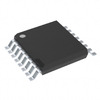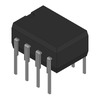Manufacturer Part Number
MAX3221CAE
Manufacturer
analog-devices
Introduction
The MAX3221CAE is a compact transceiver module for RS232 communication with integrated charge pump technology for single-supply operation.
Product Features and Performance
Single-chip RS232 interface solution
1 Driver and 1 Receiver
Full duplex communication capability
Receiver Hysteresis of 300 mV for improved noise rejection
Data Rate of up to 235Kbps
Wide voltage supply range from 3V to 5.5V
Operation within 0°C to 70°C temperature range
Surface Mount 16-SSOP form factor for PCB integration
Product Advantages
Enables portable and space-constrained applications due to small size
Integrated charge pump circuitry, which allows operation from a single supply
Low power consumption suitable for battery-powered devices
Compatible with industry-standard RS232 protocol for ease of integration
Key Technical Parameters
Protocol: RS232
Number of Drivers/Receivers: 1/1
Duplex: Full
Receiver Hysteresis: 300 mV
Data Rate: 235Kbps
Voltage - Supply: 3V to 5.5V
Operating Temperature: 0°C to 70°C
Mounting Type: Surface Mount
Package / Case: 16-SSOP
Quality and Safety Features
Robust ESD protection on transceiver interface pins
Failure protection against short-circuit conditions
Feature to enter low-power shutdown mode when not in use
Compatibility
Standard RS232 communications interface
General compatibility with digital systems through 3-5.5V supply range
Application Areas
Portable devices
Battery-powered systems
Industrial automation
Data communication equipment
Product Lifecycle
Obsolete
Potential availability of replacements or upgrades with similar specifications from analog-devices
Several Key Reasons to Choose This Product
Compact size suitable for space-restricted applications
Integrated power supply circuit reduces external component count
High data rate capabilities for rapid communication
Robust construction with ESD and fault protection increases reliability
Easy implementation in RS232 communications systems
Conforms to the industrial standard temperature range for operational flexibility





 MAX321AUK-TAnalog Devices / Maxim Integrated
MAX321AUK-TAnalog Devices / Maxim Integrated MAX321CPAAnalog Devices Inc./Maxim IntegratedIC SWITCH SPST-NC X 2 35OHM 8DIP
MAX321CPAAnalog Devices Inc./Maxim IntegratedIC SWITCH SPST-NC X 2 35OHM 8DIP MAX321ESA+Analog Devices Inc./Maxim IntegratedIC SWITCH SPST-NCX2 35OHM 8SOIC
MAX321ESA+Analog Devices Inc./Maxim IntegratedIC SWITCH SPST-NCX2 35OHM 8SOIC MAX3221CPWTexas InstrumentsIC TRANSCEIVER FULL 1/1 16TSSOP
MAX3221CPWTexas InstrumentsIC TRANSCEIVER FULL 1/1 16TSSOP MAX321ESAAnalog Devices Inc./Maxim IntegratedIC SWITCH SPST-NCX2 35OHM 8SOIC
MAX321ESAAnalog Devices Inc./Maxim IntegratedIC SWITCH SPST-NCX2 35OHM 8SOIC